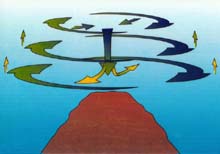
Some animals from the New England Seamount community. This image shows various corals, sponges, and a sea star. Click image for larger view.
Seamount Coral Communities
Susan Mills, Biologist
Woods Hole Oceanographic Institution
Dense aggregations of corals occur on many deep seamounts, including those in the New England Seamount chain. These populations resemble forests growing out of bare rock and provide habitat for a diverse community of invertebrates and fish, many of which are found only on seamounts. Yet for corals, which must attach to a hard surface, the rocky seamount outcrops surrounded by large areas of inhospitable terrain are like islands in the deep sea.
To colonize new seamounts, coral larvae must travel from one seamount to another during their short planktonic larval life. We know little about how coral populations are established and maintained on these seamounts, nor do we know how susceptible they might be to damage from trawling gear. Scientists hope to learn more about these questions from samples collected on this cruise.
Coral Colonization
Previous work on deep coral ecosystems has indicated that coral colonization on seamounts is rare. Because some of the corals may live to be 100 years or more, these aggregations are likely to recover very slowly, if at all, from human disturbance. To determine their vulnerability to disturbance, scientists need to know more about how these populations are formed. We do not know whether most of the corals in an established population come from other seamounts or if they are produced locally.
Coral larvae are weak swimmers. Thus, they are transported mainly by ocean currents. We do not know how long they remain in the larval stage, but it must be long enough—perhaps days to weeks—for the larvae to travel between adjacent seamounts. Leaving their native seamount may prove fatal to coral larvae because they are less likely to find a place to settle. However, certain factors can help the larvae stay near the seamounts.

This diagram (not to scale) shows the type of circulation around a seamount summit that might tend to retain larvae. Click image for larger view.
Currents Around Seamounts
When ocean currents flow past seamounts, they are diverted over and around the summit, which sometimes brings more food to filter-feeding animals like corals. These currents also spawn eddies that may help to keep larvae positioned over the seamount. In certain cases, these flows may produce a Taylor column, which is a closed circular eddy that can persist for long periods, trapping larvae above the seamount until they are ready to settle.
The behavior of the larvae may also help determine their final destination. Although they cannot swim against ocean currents, they can often swim up and down. By keeping close to the bottom, where currents typically are slower, they may improve their chances of finding a place to settle when they are ready.
Assessing Population Structure
To determine how a given population was formed, we must know two things—the ages of the individuals and how closely related they are to each other. Their ages can indicate how often settlement events occur, and their degree of relation may show whether they were produced locally or at other seamounts.
Age can be determined by measuring the levels of different isotopes in the oldest part of the coral skeleton, a process similar to carbon-14 dating. Molecular biologists will analyze samples to determine how closely they are related to each other. Comparing populations from several seamounts may enable scientists to assess potential damage from fishing activities and help to preserve these fragile communities.



















